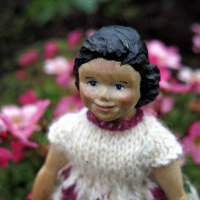Bayeux Tapestry – the Basics
So when we left off yesterday, king Edward of England had finally succeeded in ridding his kingdom of his unwanted adviser, Godwine, and Godwine’s whole family.
For a short time it looks like Edward might get to run England as he pleases. He even gets William of Normandy to cross the channel for a visit, and although we don’t know for sure, it seems that they make a deal – Edward will pass the kingdom down to William (who is his second cousin after all, whereas Harold is just his brother-in-law), in return for his support and protection.
But then Edward makes a fatal mistake. In 1051, in order to cut taxes, he disbands his mercenary fleet. A year later, Godwine and family take advantage of the now weakly protected coast to return with a strong force. Many Englishmen join his cause, possibly because they oppose the idea of a Norman succession. Edward is forced to pardon Godwine, and restore everything he had taken from the family. Even Edith returns from the nunnery.
Godwine dies in 1053, but that does not stop his family from expanding its influence – by 1060 Harold and his brothers control all of England except Mercia (a large section in the middle of England). Two of them attack Wales and win. Edward seems to give up on politics, and retreat more and more into religion and hunting (which later earns him the nickname The Confessor).
And that’s where we are when the Bayeux Tapestry opens. Edward is on the throne, looking kindly at Harold. The first half of the Tapestry shows Harold’s adventures – he sets sail (perhaps to arrange for the return of two men being held hostage in Normandy), ends up across the Channel in the hands of Guy of Ponthieu, is rescued by William of Normandy, and helps William win a decisive battle. I have not been a fan of Harold, but I would think his help in the battle would make William grateful, but instead he has to become William’s vassal. We see a ceremony in which William gives him arms, and then Harold is shown —
—well, you tell me. What do you see here?

William seated on the left, Harold standing on the right – Vassal? or just Vacillating?
I see a very unhappy man who either cannot reach both boxes at the same time, or can’t choose which one to pick. He looks conflicted about the whole situation.
But it turns out to be one of the most important scenes in the Tapestry. From the Norman point of view, he is swearing loyalty on holy relics!!! You can not take that back!
From the Anglo-Saxon point of view, he is swearing under duress!!! Everybody knows that William won’t let him return to England until he swears loyalty, so that doesn’t count! (In one written account, the Anglo-Saxons said that William hid the relics under a table, so that Harold did not even know they were there when he swore allegiance.)
Harold returns to England (with only one of the hostages) and talks to king Edward. He looks to be in trouble, maybe explaining why he was only half successful.

Harold is second from left – he does not look like a man who’s been pushing the king around and running England.
Shortly thereafter Edward dies, surrounded by only four people – Harold, Edith (who, you remember, is Harold’s sister), a servant, and a cleric. Two men hand Harold the crown, one of them pointing backward to the dead king Edward, as if to say, “That’s what he wanted!”
The center scene of the Tapestry shows Harold enthroned. Viewers would think – Is this what was supposed to happen? What about the oaths he made to William?
We immediately have some portents of doom, as people point up to a comet (which we know as Halley’s comet), and a ghost fleet shows up in the lower border.
A messenger sails over to William, William builds a fleet, and the Normans launch their invasion, with ships full of horses (new technology at the time). As they land in England, the Normans build fortifications and ravage the countryside for food, and then pause for a feast.

Warriors use their shields as portable tables; nobles have a banquet table set up for them.
I find this puzzling. Two huge events have been left out of the Tapestry – William had made an earlier attempt to sail to England, but his ships ran aground in Brittany, where the Normans jumped on the opportunity to attack the locals; while back in England, there had been a whole different invasion just a few weeks before, with Harold defeating his own brother Tostig and the king of Norway.
So, those events are skipped, but the Tapestry artists take the time and effort to show people eating? (My husband says it’s obvious – this is the commercial break. “This battle is brought to you by Channel Fisheries – for the freshest chowder, choose Channel!”)
After the feast, we have numerous scenes of the battle.

What skill at capturing the action!
The Normans fight on horseback, while the Anglo-Saxons fight on the ground, behind their wall of shields. Both sides are shown fighting bravely, and in the bottom border we see dead and dismembered bodies, and people stripping the dead of their mail shirts. Harold is killed, and the Tapestry ends with a raveled edge – the missing part is probably about 1.5 meters long, and would show William sitting on the throne.
Okay, so that’s the basic story line – if you’re just here for the history lesson, you can go now. Come back tomorrow for the conspiracy theories.
But if you are a crafty sort, and you’re interested in the actual construction of the Tapestry, here are the basics.
It is 70 meters long and 50 cm high, on a base cloth of linen.
There are nine sections, but they are sewn together so well, that the seams are very hard to notice. (It was thought there were eight sections – the ninth one was noticed in 1998, but that was not publicized until 2004, so some resources say eight.)
Two of the sections are 14 meters long, which leads historians to believe that the linen was woven on a horizontal treadle loom, which would have been new technology in Europe at the time. Traditional European looms were vertical looms, a lot like Navajo looms in our day. There are 18-19 warps per centimeter, or about 45 warps per inch. That is fine weaving, especially when you consider that all of that linen would have been spun by hand, with drop spindles.
Here’s one thing that astounds me – the cloth was initially woven at 100 cm wide, and then cut in half the long way! If you know anything about cloth, you know that when it is cut, it unravels. We weavers love a good strong selvege, and dread a cut in our cloth. It would be faster for me to weave a skinny piece of cloth the full length I needed, than to weave a wider piece of cloth, cut it in half, and hem the resulting cut sides.
The other sections are various lengths. Historians think they may have been cut up to allow more stitching teams to work on them simultaneously. (Only once in my reading have I come across the notion that maybe a mistake was made and the piece cut out, which, if I had been working on it, would surely have happened to me.)
In reading about all the changing political factions of the time, I have wondered whether some sections were cut out because they portrayed events that it was suddenly not politically expedient to show!
The embroidery yarn was all wool (with the exception of one or two small areas of linen). Three dyes were used – weld for yellow, woad for blue, and madder for red. These were used in different mixtures, to come up with a total of ten shades.
If you would like to know more about how the designer and stitchers worked, Carola Hicks has a wonderful, detailed explanation of all the materials and techniques that were used, in The Bayeux Tapestry: The Life Story of a Masterpiece. R. Howard Bloch has chapters about the source material for the illustrations in his book A Needle in the Right Hand of God: The Norman Conquest and the Making and Meaning of the Bayeux Tapestry.
Next up – some interesting theories about the Tapestry – who made it and why – and some good resources for learning more.
















Wow that was amazing and brilliant, thank you for what you have written. I was born in hastings and i still live there now, so this was drummed in us when we was at school, thank you so much for telling this story xx
Glad you liked it, since you live there! Here in the States the history we are taught in school doesn’t even begin until 1492 with Columbus 🙂 and then it is a lot less convoluted than English and European history. So I really didn’t know a thing about this until I started looking into the Bayeux Tapestry.
Also, I like to try to balance out the “girly” side of textiles with some that are more “masculine”, and I think this one qualifies. 🙂
Well you have done a very good job of it for which I thank you. I look forward to reading your next installment.
These two posts have been fascinating! English history seems so difficult to sort out–no matter how hard I try, I get confused but this helped. The weaving and stitching of the tapestry really interest me–I’ve been reading about the Great Tapestry of Scotland and love this whole idea of presenting historical moments in stitching.
I saw the book about the Great Tapestry of Scotland, and I thought, “I can’t let myself read that until I know the background of the real thing.” So I’m looking forward to that book too.
I think English history would have been easier if they had had a little more diversity in names!
My husband’s family was from England but I’ve never heard of this…very fascinating and even more so the tapestry. Very interesting. Thanks for posting this story.
As a textile lover, it’s so gratifying to see the respect that historians give this piece!
The English got tired of the French keeping the tapestry, so during the Victorian era, they made their own copy, and it is still on display in Reading!
Very interesting. Seems like so much “history of the world” happened between 950 and 1100 or so. Perhaps it isn’t that more happened then, as it is that more was recorded then. Thanks. I’m catching up, so looking forward to more.
I am amazed that we know so much about that time period. I had no idea so many people kept records, and that so many of them agree with each other, on the basic facts, if not on who was right and who was wrong.
A lot of architecture went into place then, too. So fortresses, castles, walls… same time slot. The world must have been a dangerous place… but increasingly wealthy!
Pingback: Rules, Routines, and the Restraint of Initiative | Deep in the Heart of Textiles
Pingback: TextileTopia, Part Two | Deep in the Heart of Textiles